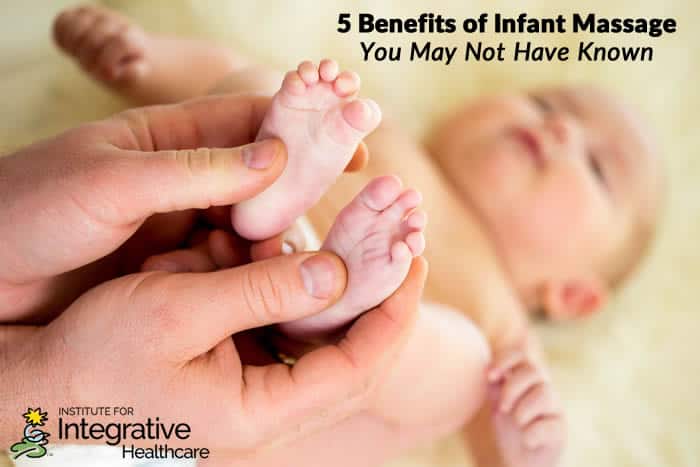

Massage has been shown to reduce stress and anxiety, reduce muscle tension and pain and increase feelings of well-being in adults – but is massage therapy just as effective for infants and children?
It turns out, it IS, and the benefits are pretty significant!
- One of the most significant benefits for infants is improved sleep. Babies who received massage demonstrated improved sleep patterns, falling asleep more easily and staying asleep longer. They have also shown improved alertness and activity during the day resulting from the improvement in sleep.
- Reduced stress behaviors have been noted in infants and young children who receive massage therapy, and studies have shown that cortisol levels were lower after receiving massage. Cortisol is a major hormone produced when we experience stress and causes inflammation throughout the body. Massage has previously been shown to reduce this stress hormone in adults, and has now been shown to reduce cortisol in children.
- Infant massage has been shown to improve motor development, especially in premature infants and those who have developmental problems. Increased responsiveness was also noted.
- Infants in NICU (Neonatal Intensive Care Unit) who received massage showed 21% more weight gain and were discharged an average of 5 days earlier than those who did not receive massage.
- When infant massage is performed by the parents, there is improved interaction and bonding between the family members. Babies greet the parents with more eye contact, smiling, vocalizing and reaching responses, and are more expressive.
How to Perform Infant Massage
Performing infant massage is easy and natural, but there are some precautions that need to be taken.
- For safety, be sure to have your supplies within reach so you do not need to leave the infant unattended, as they can roll and fall off any table, bed or other furniture you are working on.
- Ideally, working on the floor on a soft towel will allow you to sit and work with the baby on the floor in front of you.
- Be sure the baby is clean and dry before you begin.
- Babies and young children have very short attention spans, so don’t try to work for more than 15 to 20 minutes at a time, as longer time periods may begin to actually cause stress for infant and caregiver.
- Be sure to have a few soft toys on hand to distract the infant if they begin to get restless, as this may gain you a few more minutes if the baby is fussy.
Non Verbal Cues
Make eye-to-eye contact, smile and talk quietly to the baby as you are working. Take the time and opportunity to really connect with the baby, watching their nonverbal cues. If you see any signs of discomfort, such as wincing, squirming, cringing or tensing up, lighten up on the pressure. Also, if you see the baby squirming away from very light touch, you may be tickling them and need to use slightly more pressure. Babies can’t tell you if you are working too light or too deeply, so pay attention to those nonverbal cues. Most of all, remember that they are babies and some days you they are simply not going to cooperate with a massage.
Massage Oil
Use an unscented, hypoallergenic massage oil or blend when working with infants. Essential oils are often too strong for young children, so if you use any be sure to research their safety and appropriateness for use with children and do not make the blend too strong if you do use any.
Massage for Front of the Infant
Begin working with the legs and feet, applying gentle but firm effleurage. Light tapping or gentle pressure on the reflex points of the feet can often help relax the child, but can irritate some children so you will, again, need to pay attention to read the non-verbal cues. Continue with gentle clockwise circular massage on the abdomen and chest. If your baby has gas or is colic, a gentle pumping action on the legs along with gentle abdominal massage in a clockwise rotation may help alleviate gas pains. Gentle effleurage on the arms, head and neck finish the front of the body.
Massage for Back of the Infant
Turn the baby onto their stomach or side (with support) in order to apply gentle, circular effleurage on the back and hips. Again, pay attention to nonverbal cues to be sure you are not hurting or tickling the child. The nervous system is still developing in infants and they can be especially sensitive to touch.
Caregivers Benefit, Too!
Infant massage also offers benefits to those performing it, with caregivers reporting such gains as improved bonding with their baby, more confidence in caring for their infant, and better understanding of their baby’s nonverbal cues. Caregivers also enjoy a reduction in stress as they focus on their baby for the 15 to 20 minutes of well spent time!
Recommended Study:
Aromatherapy: Mother and Baby
Infant and Child Massage
Introduction to Infant Massage
Prenatal & Pediatric Massage











